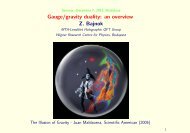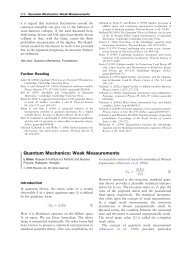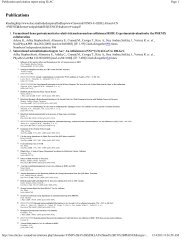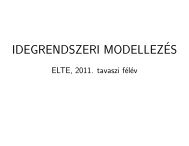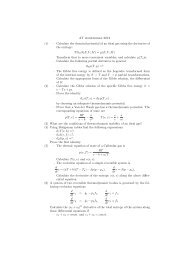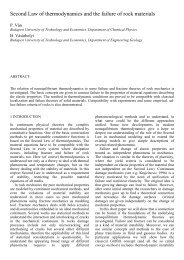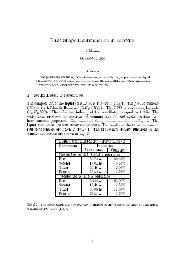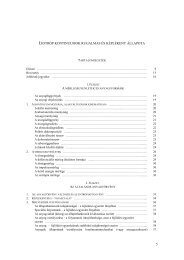hungarian scientists in the us - Columbia University
hungarian scientists in the us - Columbia University
hungarian scientists in the us - Columbia University
Create successful ePaper yourself
Turn your PDF publications into a flip-book with our unique Google optimized e-Paper software.
esearch favored research <strong>in</strong>stitutes ra<strong>the</strong>r<br />
than university sett<strong>in</strong>gs, <strong>in</strong> 1954, Olah<br />
jo<strong>in</strong>ed <strong>the</strong> Central Chemical Research Institute<br />
of <strong>the</strong> Hungarian Academy of Sciences<br />
and started a research project <strong>in</strong> organic<br />
chemistry. Also <strong>in</strong> 1954, his first son<br />
was born, George John.<br />
The popular upris<strong>in</strong>g <strong>in</strong> 1956 brought<br />
more unrest to Hungary. The Olahs, and<br />
200,000 o<strong>the</strong>r Hungarians, left <strong>the</strong> country.<br />
The Olah family went first to London,<br />
<strong>the</strong>n Montreal, <strong>the</strong>n Sarnia, Ontario, where<br />
Olah worked for Dow Chemical. He rose<br />
to <strong>the</strong> title of company Scientist. His second<br />
son, Ronald Peter, was born <strong>in</strong> 1959.<br />
George Andrew Olah<br />
Olah began his work on carbocations at<br />
this time. Olah transferred to <strong>the</strong> Dow facility<br />
<strong>in</strong> Massach<strong>us</strong>etts <strong>in</strong> 1964, and <strong>the</strong>n<br />
George Andrew Olah was born May 22,<br />
1927, <strong>in</strong> Budapest, Hungary, n<strong>in</strong>e years after<br />
<strong>the</strong> close of World War I and two years versity <strong>in</strong> Cleveland <strong>in</strong> 1965 as professor<br />
jo<strong>in</strong>ed <strong>the</strong> faculty at Western Reserve Uni-<br />
before <strong>the</strong> Great Depression. His parents and department Chair. When <strong>the</strong> chemistry<br />
departments of Western Reserve Uni-<br />
were Juli<strong>us</strong> Olah and Magda Krasznai. He<br />
grew up dur<strong>in</strong>g tumultuo<strong>us</strong> years, which versity and Case Institute of Technology<br />
<strong>in</strong>cluded World War II, when Hungary was were merged <strong>in</strong> 1967, Olah served at Chair<br />
aga<strong>in</strong> on <strong>the</strong> los<strong>in</strong>g side of a war.<br />
of <strong>the</strong> jo<strong>in</strong>t department until 1969 when he<br />
The Olah family lived a middle-class life returned to research fulltime.<br />
and Olah received his early education at a In 1976, he accepted an appo<strong>in</strong>tment to<br />
Catholic Gymnasium where he studied humanities<br />
and languages. He <strong>the</strong>n attended Los Angeles <strong>in</strong> <strong>the</strong> newly established Loker<br />
<strong>the</strong> <strong>University</strong> of Sou<strong>the</strong>rn California at<br />
<strong>the</strong> Technical <strong>University</strong> of Budapest. He Hydrocarbon Research Institute, where he<br />
chose a major <strong>in</strong> chemistry. The university is currently Dist<strong>in</strong>guished Professor and<br />
followed a rigoro<strong>us</strong> program where only Loker Chair <strong>in</strong> Organic Chemistry.<br />
<strong>the</strong> most successful students were allowed Olah was awarded <strong>the</strong> Nobel Prize <strong>in</strong><br />
to rema<strong>in</strong>. Small class sizes and an emphasis<br />
on achievement meant Olah received carbocation chemistry and for uncover-<br />
Chemistry <strong>in</strong> 1994 for his research <strong>in</strong><br />
a good foundation for his research. After <strong>in</strong>g new ways to <strong>us</strong>e hydrocarbons <strong>in</strong> <strong>the</strong><br />
graduation, he became an unpaid research petroleum <strong>in</strong>d<strong>us</strong>try.. His current research<br />
assistant to his professor, Geza Zemplen. <strong>in</strong>volves convert<strong>in</strong>g excess carbon dioxide<br />
Olah was <strong>in</strong>terested <strong>in</strong> fluor<strong>in</strong>e chemistry. and methane <strong>in</strong>to fuels and derivatives and<br />
He needed to pay for his own material and a methanol fuel cell. Olah has authored<br />
equipment. When <strong>the</strong> fumes from his projects<br />
became too noxio<strong>us</strong>, Zemplen agreed holds more than 100 patents. The George<br />
over 1000 papers and 15 books, and he<br />
to allocate space that <strong>in</strong>cluded a balcony, A. Olah Award <strong>in</strong> Hydrocarbon or Petroleum<br />
Chemistry, formerly <strong>the</strong> ACS Award<br />
so that <strong>the</strong> odors could be vented. Olah<br />
referred to this as his “balcony laboratory. <strong>in</strong> Petroleum Chemistry, is awarded from<br />
In 1949, he married Judith Lengyel. They an endowment <strong>in</strong>itially funded by The<br />
had known each o<strong>the</strong>r s<strong>in</strong>ce childhood, Morris S. Smith Foundation and <strong>the</strong> Dow<br />
and she was a secretary at <strong>the</strong> Technical Chemical Company.<br />
<strong>University</strong>. S<strong>in</strong>ce <strong>the</strong> Soviet approach to<br />
3641 3 4<br />
4



